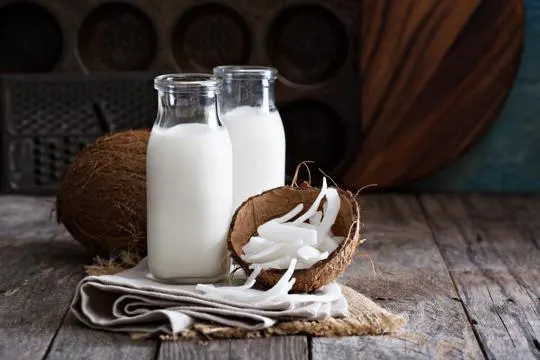Summary of key points
The main difference between condensed coconut milk and coconut milk is in their consistency and sweetness levels. Condensed coconut milk is a thick, syrupy liquid made from simmering coconut milk with sugar until it becomes dense and caramelized. On the other hand, regular coconut milk is thinner and has a more neutral taste.
In terms of usage, condensed coconut milk is often used as a sweetener or flavoring in desserts and drinks, while regular coconut milk is used as a base for curries, sauces, and soups.
It’s also important to note that condensed coconut milk is higher in calories due to the added sugar content, so it should be used sparingly. Conversely, regular coconut milk can be a healthier option when used in moderation.
Ever stood in front of the supermarket shelf, eyeing the coconut milk and its denser cousin, condensed coconut milk, wondering what on earth the difference is? We’ve all been there.
It’s all about the consistency and sweetness levels, folks. Condensed coconut milk is thicker and sweeter. Simple as that.
I once used them interchangeably in a recipe. Big mistake. Huge!
We’re here to clear the confusion. This article lays it all out.
What is Condensed Coconut Milk?

Have you heard of condensed coconut milk? It’s made by simmering regular coconut milk until most of the water has evaporated.
This gives it a thicker, richer texture.
Condensed coconut milk also has a higher concentration of natural sugars, making it a tad sweeter.
You can use it in both sweet and savory dishes.
So, if you’re looking for creaminess in your curries or flavor in your desserts, consider condensed coconut milk.
What is Coconut Milk?

Coconut milk is a nutritious and creamy liquid extracted from mature coconuts.
It’s a great ingredient for many cuisines, especially those in tropical regions.
Here are 5 points to know about coconut milk:
- Nutrient-rich: Packed with vitamins, minerals and healthy fats. It has high levels of magnesium, potassium and iron.
- Versatile: Use it in sweet or savory dishes, from curries and soups to smoothies, desserts and cocktails.
- Dairy-free: A good substitute for those with lactose intolerance or following a vegan diet.
- Health benefits: Medium-chain fatty acids (MCFAs) may help boost metabolism and support heart health.
- Packaging: Available canned, boxed or powdered – choose the one that suits your cooking needs.
Coconut milk is also a popular choice for those who want to add creaminess while avoiding dairy.
With its unique flavor and versatility, it stands out among other plant-based alternatives.
Differences Between Condensed Coconut Milk and Coconut Milk

Condensed coconut milk and coconut milk may seem similar.
But these two have distinct differences.
Knowing the distinctions between condensed and regular coconut milk will help you choose the best one for your recipe.
Ingredients Used
Condensed coconut milk and regular coconut milk may seem similar, yet they are different.
Condensed is cooked down and contains sweeteners like sugar or syrup, making it thick and rich.
Regular coconut milk is made from blending shredded coconut with water.
It has a creamy texture.
Both can be used in many recipes, but condensed adds sweetness and thickness to desserts like custards or caramel sauces.
One unique feature of condensed coconut milk is its usage in various cuisines.
It is often used in Southeast Asian dishes, like Thai sticky rice and Filipino leche flan.
A small amount can add lots of flavor.
Regular coconut milk is more widely used.
It can be found in savory curries, exotic cocktails, and vegan ice creams.
Both offer distinct flavors and textures.
Condensed gives sweetness and richness, while regular offers creaminess and natural flavors.
Knowing the difference will help you choose the right one for your recipe.
Now you know how these two variations can enhance your culinary experience without compromising taste or quality.
Consistency and Texture
Coconut milk and condensed coconut milk have key differences, especially when it comes to texture and consistency.
Here’s what you need to know:
- Coconut milk is usually thin and silky; like a liquid.
- Condensed coconut milk is thicker and denser, almost like syrup.
- Condensed coconut milk is great for desserts that need creaminess.
- Coconut milk is used in curries, soups and smoothies.
- Texture affects the overall taste and mouthfeel of a dish.
Plus, the process of making these milks creates the distinct textures.
This means you can choose the right one for the right dish.
So if you want a silky base or a sweet dessert, you know what to do.
Flavor and Taste
Condensed coconut milk and regular coconut milk have different flavors and tastes.
Condensed coconut milk has a rich, sweet flavor like caramel or butterscotch.
It’s thick with a strong taste that adds depth and sweetness.
Regular coconut milk is lighter and more subtle.
It tastes creamy, with a hint of natural sweetness.
Both are great for adding flavor to dishes.
Why not try both and find your favorite?
Sweetness Level
Condensed coconut milk is much sweeter than regular coconut milk.
It has sugar added during the condensing process.
When cooking with condensed coconut milk, adjust sweeteners accordingly.
Regular coconut milk has a more subtle sweetness.
Plus, it’s not as thick as condensed milk as the condensing process changes texture.
Condensed coconut milk is great for sweets, but use regular coconut milk to add complexity to dishes.
Remember: adjust sweeteners when using condensed coconut milk.
Similarities Between Condensed Coconut Milk and Coconut Milk

Condensed and regular coconut milk have much in common.
Both come from coconuts and have a creamy texture.
Plus, they’re used in many global cuisines.
A major similarity is their versatility.
You can use them for savory dishes or sweet desserts.
Curries, smoothies – any dish can be enhanced with a hint of tropical taste.
Nutritionally, both kinds offer vitamins, minerals, and healthy fats.
Plus, they’re often used as dairy alternatives by vegans and those who are lactose intolerant.
Though they have similarities, there are differences.
Condensed has a thicker consistency and sweeter taste.
It’s ideal for adding richness and sweetness to desserts.
Regular is thinner and has a more subtle flavor.
Great for soups, sauces, and beverages like piña coladas.
Cooking and Baking Uses of Condensed Coconut Milk and Coconut Milk
Curious about the possibilities of condensed coconut milk and coconut milk? Both are creamy and great for adding a tropical flair to your cooking.
Condensed coconut milk is thick and sweet.
It’s commonly used in desserts like flans, puddings, and ice creams.
It lends sweetness and richness to these treats.
Coconut milk is the liquid from grated coconut flesh.
It has a lighter consistency and works for sweet and savory dishes.
Curries, soups, smoothies, and dairy-free coffee/tea substitutes can all use coconut milk.
Baked goods also benefit from these milks.
Condensed coconut milk can replace cow’s milk or cream in cakes.
It gives the product moisture and sweetness.
Regular coconut milk works in muffins, breads, and cookies too.
The nutty flavor adds moisture. These milks have many other uses.
In Thai-inspired stir-fries or creamy sauces like curry or alfredo, they’re invaluable.
They also make great marinades for meats or tofu.
So, if you’re dreaming of decadent desserts or experimenting with savory dishes, condensed coconut milk and coconut milk will take your cooking to new heights.
Health Considerations and Nutritional Differences
Comparing condensed and regular coconut milks is essential for health and nutrition.
Condensed milk is highly concentrated and has less water, so it’s thicker and has a richer flavor.
It also usually has added sweeteners like cane sugar or corn syrup, while regular coconut milk has natural sugars from coconuts.
Both are great sources of healthy fats like MCTs.
But, condensed milk may have more calories, so those watching their intake may choose regular coconut milk.
Condensed milk is perfect for desserts and sweets due to its creamy texture and intense flavor.
Regular coconut milk is better for savory dishes like curries and soups.
Knowing the differences helps pick the right type for dietary needs and preferences.
Conclusion
After reading this breakdown of condensed coconut milk and coconut milk, it should be easier to make an informed decision about which type is best for you.
Whether you use it in a pastry recipe, curry, hot chocolate, or whatever your heart desires, you’ll now be able to make the most out of both substances and enjoy lots of variation in your culinary creations.
For further information about what works best for particular dishes, do more research online or ask friends or family who may have tried it out before making a final decision.
And remember – no matter the dish, all coconuts start from nature so don’t forget to thank the source of our delicious bounty.

Leave a comment